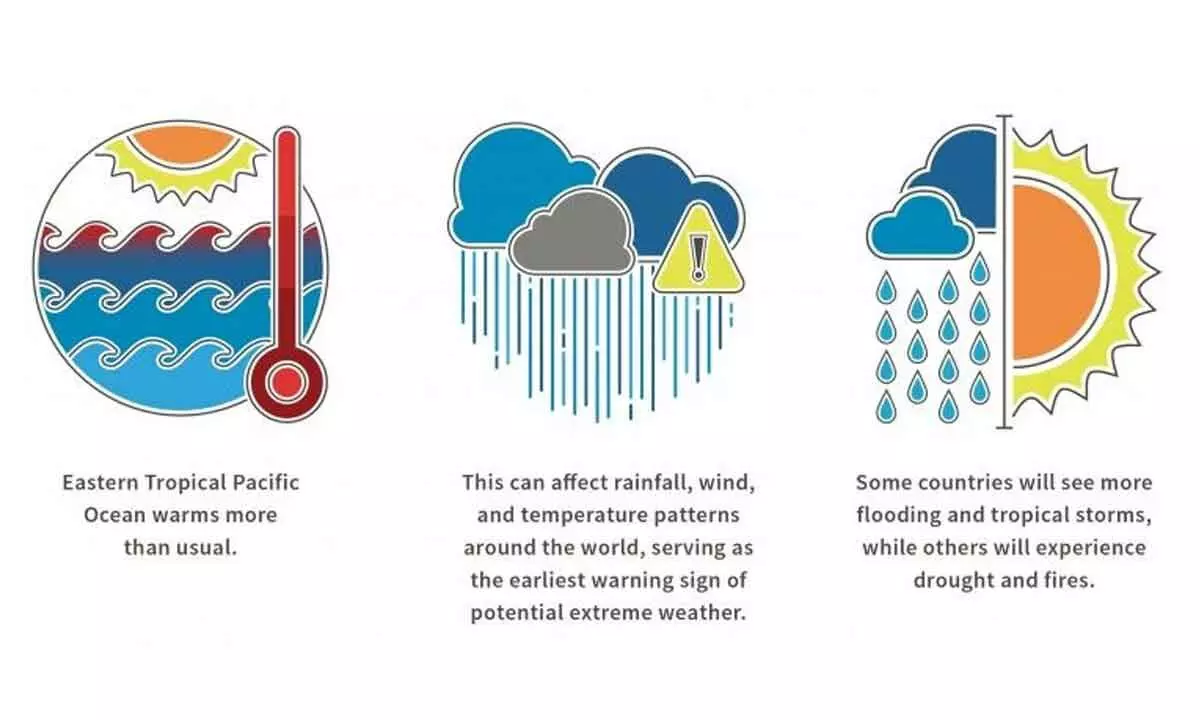El Nino threat begins to loom all over

New records in temperatures likely, in areas that already saw above-average levels
The last El Nino event occurred between February and August 2019, but its impacts were relatively weak. As the world, including India, stares at extreme weather and climate events like agonizing heat waves, deadly cyclone and drought risks owing to monsoon deficit, the ocean-warming phenomenon El Nino is officially here and could last until 2024, scientists have warned
China on Tuesday ramped up its flood control and disaster relief efforts to safeguard people’s lives and properties amid the growing El Nino threat. China’s State Flood Control and Drought Relief headquarters scaled up its level-IV emergency response to flooding to include eight provincial-level regions. “The emergence of the El Nino event marks the return of the traditional way of “wet in the south and dry in the north” in China, according to Zhou Bing, chief expert on climate services at the China Meteorological Administration.
Last week, the Ministry of Agriculture and Rural Development in Mexico had announced that the spate of bird deaths along the country’s Pacific coast is linked to the warming ocean waters caused by El Nino, and not avian flu. Many seabirds have died recently in this region, with more than 90 per cent of the affected birds being grey-backed shearwaters, according to Mexican authorities. This phenomenon has also been reported from Peru, Chile and other latitudes of the world when an El Nino occurs.
The American Oceanic and Atmospheric Administration (NOAA) has announced that El Nino arrived as the atmospheric response to the warmer-than-average tropical Pacific sea surface kicked in over the past month.
El Nino events usually occur every two to seven years and are characterised by warmer-than-average sea surface temperatures around the equator in the central and eastern Pacific Ocean, Space.com reported.
The last El Nino event occurred between February and August 2019, but its impacts were relatively weak. As the world, including India, stares at extreme weather and climate events like agonizing heat waves, deadly cyclone and drought risks owing to monsoon deficit, the ocean-warming phenomenon El Nino is officially here and could last until 2024, scientists have warned.
According to the US National Oceanic and Atmospheric Administration (NOAA), El Nino could lead to new records for temperatures, particularly in areas that already experience above-average temperatures during El Nino. El Nino events usually occur every two to seven years and are characterized by warmer-than-average sea surface temperatures around the equator in the central and eastern Pacific Ocean, reports Space.com.
The last El Nino event occurred between February and August 2019 but its impacts were relatively weak. “Depending on its strength, El Nino can cause a range of impacts, such as increasing the risk of heavy rainfall and droughts in certain locations around the world,” Michelle L’Heureux, a physical scientist at NOAA’s Climate Prediction Center, said in a statement recently.
“El Nino could lead to new records for temperatures, particularly in areas that already experience above-average temperatures during El Nino,” he added. Last month, Kelvin waves, a potential precursor of El Nino conditions in the ocean, rolled across the equatorial Pacific toward the coast of South America. According to NASA, the data showed Kelvin waves – which are roughly 2 to 4 inches (5 to 10 cm) high at the ocean surface and hundreds of miles wide – moving from west to east along the equator toward the west coast of South America.
The advent of El Nino this year could push global temperatures into uncharted territory and contribute to global warming crossing the 1.5 degree Celsius threshold within the next five years, which would lead to catastrophic and irreversible climate breakdown, according to reports.
“We’ll be watching this El Nino like a hawk,” said Josh Willis, a project scientist at NASA’s Jet Propulsion Laboratory in Southern California. “If it’s a big one, the globe will see record warming, but here in the southwest US we could be looking at another wet winter, right on the heels of the soaking we got last winter,” Willis said. Global temperatures have accelerated to record-setting levels this month, an ominous sign in the climate crisis ahead of a gathering El Nino that could potentially propel 2023 to become the hottest year ever recorded.
Extreme hot weather caused by the El Nino phenomenon is predicted to drag up to 8,70,000 hectare of agricultural lands in Indonesia into drought and crop failures. In India, El Nino Southern Oscillation (ENSO) led to a delay in monsoon, while cyclone Biparjoy also played a crucial role in the delay, according to experts.
“In April 2023, an El Nino ‘watch’ was issued, signaling the beginning of the warm phase of the ENSO phenomenon. Since then, all the Nino indices have remained positive-neutral or above the designated threshold. The Nino indices in the western half of the equatorial Pacific Ocean are still on the borderline, while the eastern portion consistently displays sufficient warming,” said a Skymet official.














